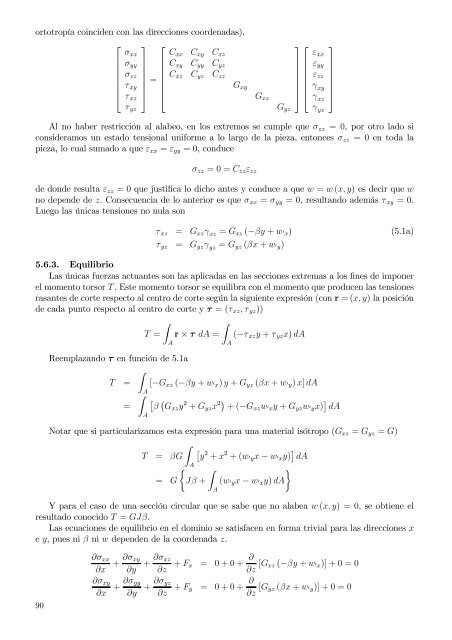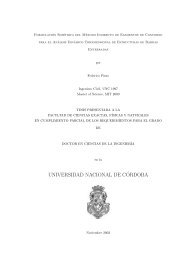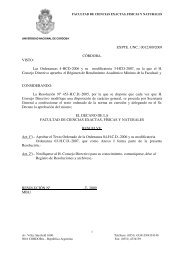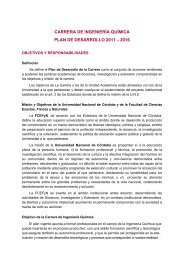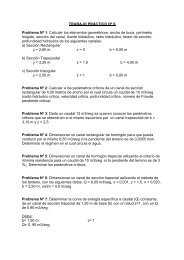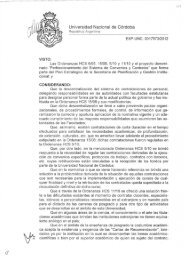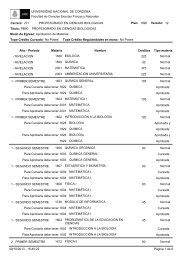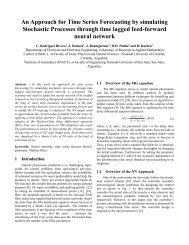Capítulo 1 Métodos de residuos ponderados Funciones de prueba ...
Capítulo 1 Métodos de residuos ponderados Funciones de prueba ...
Capítulo 1 Métodos de residuos ponderados Funciones de prueba ...
You also want an ePaper? Increase the reach of your titles
YUMPU automatically turns print PDFs into web optimized ePapers that Google loves.
ortotropía coinci<strong>de</strong>n con las direcciones coor<strong>de</strong>nadas).<br />
⎡ ⎤ ⎡<br />
⎤ ⎡<br />
σ xx C xx C xy C xz<br />
σ yy<br />
C xy C yy C yz<br />
σ zz<br />
⎢ τ xy<br />
=<br />
C xz C yz C zz ⎥ ⎢<br />
G xy ⎥ ⎢<br />
⎣ τ xz<br />
⎦ ⎣<br />
G xz<br />
⎦ ⎣<br />
τ yz<br />
G yz<br />
Al no haber restricción al alabeo, en los extremos se cumple que σ zz = 0, por otro lado si<br />
consi<strong>de</strong>ramos un estado tensional uniforme a lo largo <strong>de</strong> la pieza, entonces σ zz = 0 en toda la<br />
pieza, lo cual sumado a que ε xx = ε yy = 0, conduce<br />
σ zz = 0 = C zz ε zz<br />
<strong>de</strong> don<strong>de</strong> resulta ε zz = 0 que justifica lo dicho antes y conduce a que w = w (x, y) es <strong>de</strong>cir que w<br />
no <strong>de</strong>pen<strong>de</strong> <strong>de</strong> z. Consecuencia <strong>de</strong> lo anterior es que σ xx = σ yy = 0, resultando a<strong>de</strong>más τ xy = 0.<br />
Luego las únicas tensiones no nula son<br />
ε xx<br />
ε yy<br />
ε zz<br />
γ xy<br />
γ xz<br />
γ yz<br />
τ xz = G xz γ xz = G xz (−βy + w′ x) (5.1a)<br />
τ yz = G yz γ yz = G yz (βx + w′ y)<br />
5.6.3. Equilibrio<br />
Las únicas fuerzas actuantes son las aplicadas en las secciones extremas a los fines <strong>de</strong> imponer<br />
el momento torsor T . Este momento torsor se equilibra con el momento que producen las tensiones<br />
rasantes <strong>de</strong> corte respecto al centro <strong>de</strong> corte según la siguiente expresión (con r = (x, y) la posición<br />
<strong>de</strong> cada punto respecto al centro <strong>de</strong> corte y τ = (τ xz , τ yz ))<br />
∫<br />
∫<br />
T = r × τ dA = (−τ xz y + τ yz x) dA<br />
A<br />
Reemplazando τ en función <strong>de</strong> 5.1a<br />
∫<br />
T = [−G xz (−βy + w′ x) y + G yz (βx + w′ y) x] dA<br />
∫A<br />
[ (<br />
= β Gxz y 2 + G yz x 2) + (−G xz w′ xy + G yz w′ yx) ] dA<br />
A<br />
Notar que si particularizamos esta expresión para una material isótropo (G xz = G yz = G)<br />
∫<br />
[<br />
T = βG y 2 + x 2 + (w′ yx − w′ xy) ] dA<br />
A<br />
{ ∫<br />
}<br />
= G Jβ + (w′ yx − w′ xy) dA<br />
A<br />
Y para el caso <strong>de</strong> una sección circular que se sabe que no alabea w (x, y) = 0, se obtiene el<br />
resultado conocido T = GJβ.<br />
Las ecuaciones <strong>de</strong> equilibrio en el dominio se satisfacen en forma trivial para las direcciones x<br />
e y, pues ni β ni w <strong>de</strong>pen<strong>de</strong>n <strong>de</strong> la coor<strong>de</strong>nada z.<br />
A<br />
⎤<br />
⎥<br />
⎦<br />
90<br />
∂σ xx<br />
+ ∂σ xy<br />
∂y<br />
∂x<br />
∂σ xy<br />
∂x + ∂σ yy<br />
∂y<br />
+ ∂σ xz<br />
∂z + F x = 0 + 0 + ∂ ∂z [G xz (−βy + w′ x)] + 0 = 0<br />
+ ∂σ yz<br />
∂z + F y = 0 + 0 + ∂ ∂z [G yz (βx + w′ y)] + 0 = 0


